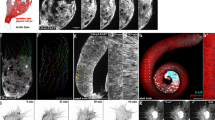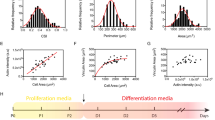Summary
Time-lapse cinematography elucidates the genesis of a uniform and approximately linearly arranged myogenic cell aggregate, stemming from two larger cell groups. The ultimate aggregate is created by continuous movement of one cell group toward the other. Following this motion, the angle between the cell groups is reduced as they approach each other.
Different patterns of cell motility can be recognized. Some cells move in a preferred direction in relation to the aggregate as a whole, whereas others alter their direction of movement.
The myogenic cells are aligned end-to-end and side-by-side. The latter is often accomplished in the following manner: two cells in end-to-end contact form as crescent-shaped free space with their polar extensions; a neighboring spindle-shaped cell then settles in this space. An arrangement of cells such that their greatest cytoplasmic widths lie at the same level can also be seen. During the recording period, two cells in one of the groups were replicating. One of them realized karyo- and cytokinesis in approximately 80min. The daughter cells moved apart in opposite directions, but never lost contact to the aggregate. This observation shows that contact between presumptive myoblasts and myoblasts is established.
Similar content being viewed by others
References
Albrecht-Buehler G (1977) Daughter 3T3 cells. Are they images of each other? J Cell Biol 72:595–603
Beierle JW (1968) Cell proliferation: enhancement by extracts from cell surfaces of polyoma-virus-transformed cells. Science 161:798–799
Bennett HS (1963) Morphological aspects of extracellular polysaccharides. J Histochem Cytochem 11:14–23
Bischoff R (1978) Myoblast fusion. In: Poste G, Nicolson GL (eds) Cell Surface Reviews. Elsevier/North-Holland Biomedical Press, Amsterdam New York Oxford, Vol 5, pp 127–179
Bischoff R, Holtzer H (1968) The effect of mitotic inhibitors on myogenesis in vitro. J Cell Biol 36:111–127
Bischoff R, Lowe M (1974) Cell surface components and the interaction of myogenic cells. In: Milhorat AT (ed) Exploratory Concepts in Muscular Dystrophy II. Exerpta Medica, Amsterdam, pp 17–29
Capers CR (1960) Multinucleation of skeletal muscle in vitro. J Biophys Biochem Cytol 7:559–565
Chiquet M, Eppenberger HM, Moor H, Turner DC (1975) Application of freeze-etching to the study of myogenesis in cell culture. Exp Cell Res 93:498–502
Codington JF, Sanford BH, Jeanloz RW (1970) Glycoprotein coat of the TA3 cell. I. Removal of carbohydrate and protein material from variable cells. J Natl Cancer Inst 45:637–647
Cooper WG, Konigsberg IR (1961) Dynamics of myogenesis in vitro. Anat Rec 140:195–205
Culp LA, Black PH (1972) Release of macromolecules from Balb/C mouse cell lines treated with chelating agents. Biochemistry 11:2161–2172
Den H, Malinzak DA, Keating HJ, Rosenberg A (1975) Influence of concanavalin A, wheat germ agglutinin, and soybean agglutinin on the fusion of myoblasts in vitro. J Cell Biol 67:826–834
Dienstman SR, Holtzer H (1975) Myogenesis: a cell lineage interpretation. In: Holtzer H, Reinert J (eds) The Cell Cycle and Cell Differentiation. Springer, Berlin Heidelberg New-York, pp 1–25
Doering JL, Fischman DA (1977) A fusion-promoting macromolecular factor in muscle conditioned medium. Exp Cell Res 105:437–443
Fear J (1977) Observations on the fusion of chick embryo myoblasts in culture. J Anat 124:437–444
Hay ED (1963) The fine structure of differentiating muscle in the salamander tail. Z Zellforsch 59:6–34
Kalderon N, Epstein ML, Gilula NB (1977) Cell-to-cell communication and myogenesis. J Cell Biol 75:788–806
Keeter JS, Pappas GD, Model PG (1975) Inter- and intramyotomal gap junctions in the axolotl embryo. Dev Biol 45:21–33
Knudsen KA, Horwitz AF (1977) Tandem events in myoblast fusion. Dev Biol 58:328–338
Konigsberg IR (1971) Diffusion-mediated control of myoblast fusion. Dev Biol 26:133–152
Noble PB, Peterson SC (1974) Analysis of the movements of myogenic cells during muscle organogenesis in vitro. Can J Physiol Pharmacol 52:901–905
Okazaki K, Holtzer H (1965) An analysis of myogenesis in vitro using fluorescein-labeled antimyosin. J Histochem Cytochem 13:726–739
Przybylski RJ, Blumberg JM (1966) Ultrastructural aspects of myogenesis in the chick. Lab Invest 15:836–863
Rash JE, Fambrough D (1973) Ultrastructural and electrophysiological correlates of cell coupling and cytoplasmic fusion during myogenesis in vitro. Dev Biol 30:168–186
Rash JE, Staehelin LA (1974) Freeze-cleave demonstration of gap junctions between skeletal myogenic cells in vivo. Dev Biol 36:455–461
Sanger JW (1974) The use of cytochalasin B to distinguish myoblasts from fibroblasts in cultures of developing chick striated muscle. Proc Natl Acad Sci USA 71:3621–3625
Shimada Y (1971) Electron microscope observations on the fusion of chick myoblasts in vitro. J Cell Biol 48:128–142
Shimada Y, Fischman DA, Moscona AA (1967) The fine structure of embryonic chick skeletal muscle cells differentiated in vitro. J Cell Biol 35:445–453
Solomon F (1979) Detailed neurite morphologies of sister neuroblastoma cells are related. Cell 16:165–169
Turner DC (1978) Differentiation in cultures derived from embryonic chicken muscle. Differentiation 10:81–93
Yaffe D (1971) Developmental changes preceding cell fusion during muscle differentiation in vitro. Exp Cell Res 66:33–48
Author information
Authors and Affiliations
Additional information
This research was supported by a grant from the Deutsche Forschungsgemeinschaft (Ba 689/1)
Rights and permissions
About this article
Cite this article
Bachmann, P. Motility, linear arrangement and cell-to-cell contact of myogenic cells prior to fusion. Cell Tissue Res. 206, 431–440 (1980). https://doi.org/10.1007/BF00237972
Accepted:
Issue Date:
DOI: https://doi.org/10.1007/BF00237972




